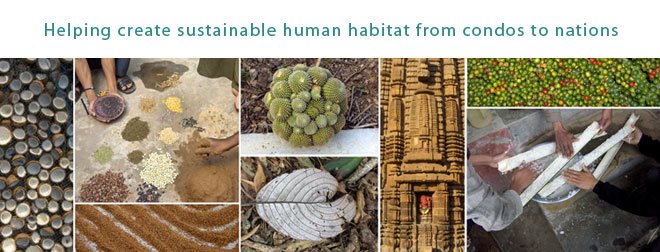
Permaculture is a design system to create sustainable, regenerative systems. For food production systems (agriculture) this means that not only will they sustain over time, but also that the system is inherently resilient to the challenges and stresses of various types and intensities, has qualities that gives it a sense of adaptability, and creates mutually beneficial linkages and relationships with other systems as well as the larger system it is a part of. How it does this is by focusing on relationships. While it is important that parts of a system be appropriate and adhere to the Ethics of Permaculture (Care for Earth, Care For People, Fair Share/Reinvest surplus) it is by the relationships that we create between them that true sustainability and resiliency occurs. Permaculture does this on several levels.
First and primary Permaculture has a set of principles that form guidelines and avenues by which we can design sustainable systems. In addition these principles can be used to look at and understand systems already in place, thus allowing us to intervene and adjust in appropriate and sustainable ways to improve (step up) the system. For a farmer this means a better understanding of resource management (from seed, to water, to manure, to time and labor) and how these move thru their farm to influence and create or reduce yields. This movement of resources as well as the movement of all parts of an environment (including the human generated ones) is referred to as flows. Permaculture creates resiliency by weaving these flows into a complexity. It is through a diverse, complex web of elements and relationships that a system is able to endure even in times of stress from disease and pests, drought and flood, as well as the fluctuations that are inherent in a market economy. On a farm one thing this means is that within a given context of space, time and the environment a greater number of species can be grown and a complexity of cropping and support systems will be created and linked. In addition, relationships beyond the farm will be optimized for the benefit of all concerned.
Another level, one of the gems of Permaculture, is Pattern Literacy and Application. This is a part of the foundation of Permaculture designing and understanding of systems, from the farm to the greater context in which the farm exists, and another level to creating sustainability and resilience. Patterning includes individual flows, how these flows interact and layer to create patterns, as well as how to apply patterns in design to match and optimize the natural patterns and flows of a specific site. A distinct advantage that will aid the farmer through Pattern Literacy will be the ability to recognize points of opportunity. These are points (nodes) within a system (pattern) where a simple intervention leads to complex and far reaching results.
Related to this is Sector Analysis, a Permaculture tool for understanding how flows move across a particular site. Again, a Flow can be physical (water, fire, manure, seeds, animals etc.), invisible (economic, information, etc.), or anything else that can be considered to move within or through a system. A flow can originate in or outside the system. With Sector analysis a map (pattern) of flows is created to get a better and deeper understanding of what is shaping and influencing the system. Sector Analysis informs how elements are or can be placed within the context of a particular site to optimize for appropriateness and sustainability. In Permaculture design this is called Right Placement.
Coupled with Sector Analysis is another Permaculture tool called Zonation. Zonation is a way by which parts (elements) of a system are placed in relationship to maximize beneficial relationships and minimize the inputs necessary to maintain and utilize them. On a farm this would involve the relationships between cowshed, garden, farmhouse, water, orchard, and all other aspects of the farm. Zonation facilitates the creation of a diverse and complex web of interactions between a set of elements that requires the minimum input of external resources. It also maximizes the functionality between the varied elements on the farm. This is called Relative Placement.
With Relative and Right Placement resiliency is designed into and becomes a natural outcome of the system. Like a web, if one or several strands (relationships) were to break the web survives. Together Sector Analysis and Zonation are another layer by which Permaculture creates these beneficial and complex relationships.
These (Ethics, Principles, Flows, Patterns, Sector Analysis, and Zonation) are all parts of the Design Process and are part of the core of Permaculture. What a permaculturalist is at heart is an opportunist. As long as the design, technique or strategy adheres to or the intervention falls within the Permaculture Ethics, and the Principles are applied, than Permaculture is being practiced. While this may sound simple, if you really understand and skillfully apply these Principles and Ethics very specific and functional outcomes occur. It should be understood that while being very specific Permaculture has great flexibility and adaptability to local conditions. Because Permaculture is about relationships and less about objects (elements) it is very site specific, taking into account not only the physical uniqueness of a place but also the culture and history as well. In fact and practice it recognizes the value of traditional indigenous knowledge. Permaculture seeks to preserve and honour this storehouse of sustainability while also coupling it with the realities of the world today. It is through this site specific approach and honouring of local culture, history, and traditional practices that Permaculture is being applied in over 120 countries worldwide, in conditions ranging from high altitude deserts to the wet tropics, from extremely cold to extremely hot climates, from small farms of less than an acre to ones of many hundreds and thousands of acres.




